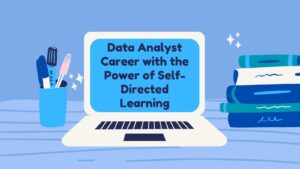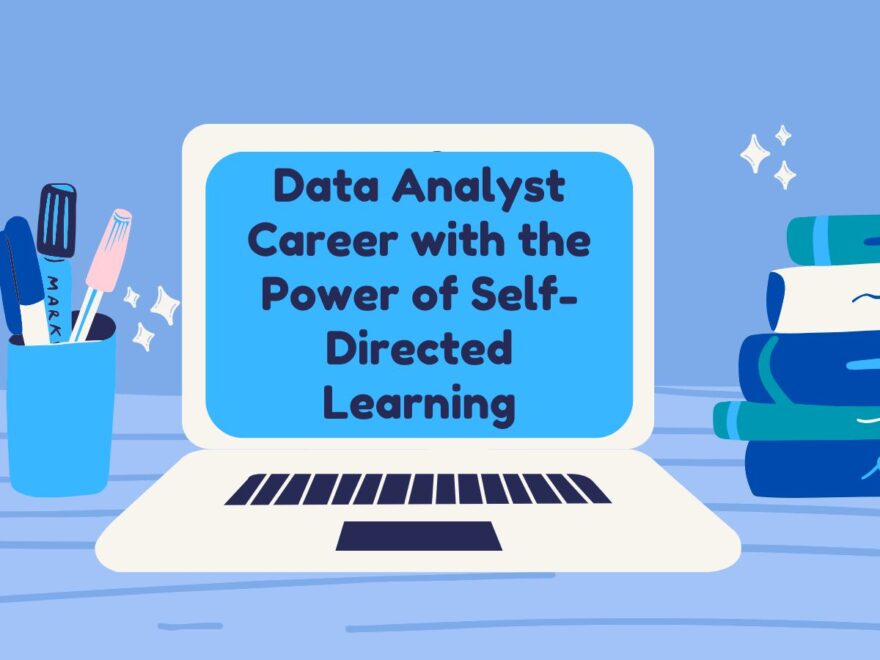Data Analyst Career opportunities are rapidly expanding in today’s data-driven economy, with industries across the globe seeking professionals who can turn raw data into actionable insights. However, formal education is no longer the only path to enter this dynamic field. Self-directed learning—where individuals take initiative to gain skills independently—has emerged as a powerful and flexible way to build and advance a data analyst career.
Whether you’re transitioning from a different profession or aiming to upskill, self-directed learning empowers you to take control, master essential tools, and stay competitive in an ever-evolving landscape.
Why Self-Directed Learning is a Game-Changer in Data Analytics
Self-directed learning puts you in control of your professional development. Unlike structured academic programs, it offers flexibility to choose what you learn, how you learn, and at what pace. This independence not only builds technical competency but also cultivates critical soft skills such as problem-solving, initiative, and adaptability.
Key benefits include:
- Personalized learning paths tailored to your goals
- Real-world project experience through hands-on practice
- Cost-effective access to high-quality resources
- Increased confidence from self-mastery
This approach allows you to stay current with industry tools and trends—crucial in a domain as dynamic as data analytics.
Connect on LinkedIn to Learn Data Analytics with Me !
Key Tools Every Self-Taught Data Analyst Must Master
A successful data analyst must be proficient in a combination of foundational tools, technical skills, and visualization platforms. Here are the core tools and technologies to focus on:
1. Excel
Despite the rise of more sophisticated tools, Excel remains a fundamental analytical tool in business. Learning pivot tables, data cleaning, conditional formatting, and formulas can dramatically boost your productivity and understanding of data structures.
2. Power BI
Power BI is a leading business intelligence tool used for creating interactive dashboards and reports. It integrates seamlessly with Microsoft products and is essential for roles involving business reporting and decision-making insights.
3. Tableau
Tableau is a top-tier data visualization platform. It enables users to turn raw data into compelling visual stories. Mastering Tableau enhances your ability to communicate insights effectively, which is a vital skill for any analyst.
4. SQL (Structured Query Language)
SQL is the backbone of data retrieval. As a data analyst, the ability to write and understand queries is critical when working with relational databases such as MySQL, PostgreSQL, or SQL Server.
5. Python or R
Programming knowledge in Python or R allows analysts to automate tasks, perform complex data analysis, and utilize statistical or machine learning techniques. Python, with libraries like Pandas, NumPy, and Matplotlib, is especially popular in the analytics community.
6. Jupyter Notebooks / Google Colab
These tools are excellent environments for writing code, visualizing data, and creating reproducible analysis workflows. They’re widely used in both academic and professional settings.
7. Kaggle
A community-driven platform that offers free datasets, code notebooks, and competitions. Kaggle is ideal for practicing and benchmarking your skills.
Step-by-Step Guide to Launching Your Career via Self-Directed Learning
1. Identify Learning Objectives
Start by clearly defining your career goals and the skills you need. For a data analyst, core competencies include:
- Statistical analysis
- Data visualization
- Data wrangling
- Business acumen
- Communication skills
Break these into smaller, actionable learning goals with timelines.
2. Utilize Online Resources
Leverage learning platforms such as:
- Coursera – Offers structured courses from top universities
- edX – Great for deep dives into statistics and data science
- Udemy – Affordable, bite-sized learning modules
- Khan Academy – Free tutorials on math and statistics
- YouTube Channels – Like Alex The Analyst or Data School
Choose resources that match your current level and learning style.
3. Hands-On Practice
Theory is important, but application is where learning solidifies. Use platforms like:
- Kaggle – Work with real-world datasets
- DataCamp or LeetCode – Practice coding and analysis challenges
- GitHub – Host your code and show your progress
Build mini-projects like sales dashboards, customer segmentation reports, or predictive models.
4. Build a Portfolio
A portfolio showcases your abilities beyond your resume. Include:
- Problem statement
- Your approach
- Tools used
- Visualizations or dashboards
- Key insights and business impact
Make it public through personal blogs, GitHub, or portfolio websites.
5. Engage with the Data Community
Being part of a community accelerates growth. You can:
- Join LinkedIn groups or Reddit communities like r/datascience
- Participate in hackathons or data meetups
- Follow and interact with data influencers on Twitter or Medium
Engaging helps you stay updated and gather feedback.
6. Commit to Continuous Learning
Data analytics evolves rapidly with new tools and practices. Maintain a habit of:
- Reading blogs (e.g., Towards Data Science)
- Subscribing to newsletters like Data Elixir or KDnuggets
- Taking advanced courses
- Attending webinars and virtual conferences
Being a lifelong learner is key to long-term career success.
Get Your CV Ready for Free to Launch Your Data Analyst Career
Making Informed Career Decisions in Data Analysis
Choosing a data analyst career path requires more than just learning tools. It’s essential to evaluate:
– Job Market Trends
Research roles in industries like finance, health, retail, and tech. Data roles vary by sector, so understand where your interests align.
– Your Strengths and Preferences
Some analysts focus on storytelling and dashboards (BI Analysts), while others go deeper into code and modeling (Data Scientists). Tailor your path accordingly.
– Certifications and Credentials
While not always necessary, certifications in Tableau, Power BI, or Google Data Analytics can help validate your skills.
– Location and Remote Opportunities
Data analyst roles are increasingly remote-friendly. Use this to explore global job markets and diversify your experience.
Best Posts to Learn Data Analytics
- Top 5 Data Analysis Techniques You Need to Know in 2025
 Data analysis is the backbone of modern decision-making. In 2025,
Data analysis is the backbone of modern decision-making. In 2025, - How Data Analysis Can Improve Business Decisions in 2025?
 In today’s fast-paced and data-driven world, companies no longer make
In today’s fast-paced and data-driven world, companies no longer make - Unlock Your Data Analyst Career with the Power of Self-Directed Learning
 Data Analyst Career opportunities are rapidly expanding in today’s data-driven
Data Analyst Career opportunities are rapidly expanding in today’s data-driven
Challenges and How to Overcome Them
– Lack of Structure
Combat this by setting a schedule and using tools like Trello or Notion to track your learning.
– Overwhelm
Start with one tool or topic at a time. Don’t try to learn everything at once.
– Imposter Syndrome
Remind yourself that progress takes time. Reflect on how far you’ve come and seek mentorship when needed.
Final Thoughts: Own Your Journey
Self-directed learning can be both challenging and liberating. It gives you the power to build a unique and rewarding career without waiting for formal programs or gatekeepers. By mastering essential tools like Excel, Power BI, Tableau, and SQL, and committing to continuous, hands-on learning, you can unlock limitless career possibilities.
Whether you’re just starting or looking to upskill, remember: the best investment you can make is in yourself.
Are you on a self-directed learning journey? What tools or tips have helped you the most? Share your experience in the comments below!
Ready to get started?
Build your data analyst skills now—your career transformation begins with one small, focused step today.
What are some career opportunities for data analysts?
Data analysts can pursue various career paths in industries such as finance, healthcare, marketing, e-commerce, and technology. Common job titles include data analyst, business analyst, data scientist, market analyst, and financial analyst.
Understanding the diverse career opportunities available in data analysis allows beginners to explore different paths and tailor their skills and experiences accordingly.
How can I build a portfolio as a beginner in data analysis?
Beginners can build a portfolio by working on personal projects, participating in online competitions (e.g., Kaggle), contributing to open-source projects, or showcasing analyses and visualizations on platforms like GitHub or personal websites.
A strong portfolio demonstrates practical skills and expertise, allowing beginners to showcase their abilities to potential employers and clients.
Do I need a degree in data science or related fields to become a data analyst?
While a degree in fields like statistics, mathematics, computer science, or economics can provide a strong foundation for a career in data analysis, it is not always necessary. Many successful data analysts have acquired skills through self-directed learning, online courses, and practical experience.
Employers often prioritize practical skills and experience over formal education, making it possible for individuals from diverse backgrounds to enter the field of data analysis.
What are some common tools and software used in data analysis?
Data analysts often use a variety of tools and software, including programming languages like Python and R, data visualization tools such as Tableau and Matplotlib, and database querying languages like SQL.
Familiarity with these tools and software is essential for performing data analysis tasks efficiently and effectively, and for staying competitive in the job market.
How can I learn data analysis if I don’t have a background in it?
There are numerous resources available for individuals without a formal background in data analysis, including online courses, tutorials, books, and hands-on projects.
These resources provide opportunities for self-directed learning, allowing beginners to acquire the necessary skills and knowledge at their own pace and convenience.
What skills do I need to become a data analyst?
Data analysts require a combination of technical skills such as proficiency in programming languages (e.g., Python, R), statistical analysis, data visualization, and database querying, as well as soft skills like critical thinking, problem-solving, and communication.
Possessing these skills allows individuals to effectively manipulate, analyze, and communicate insights from data, essential for success in the field of data analysis.
What is data analysis, and why is it important?
Data analysis involves examining, cleansing, transforming, and interpreting data to extract valuable insights and inform decision-making processes.
Data analysis is crucial for businesses and organizations to understand trends, patterns, and correlations within their data, leading to informed strategic decisions, improved operations, and competitive advantages.

